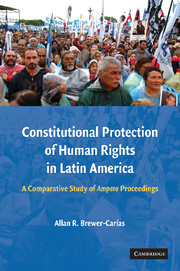 Constitutional Protection of Human Rights in Latin America
Constitutional Protection of Human Rights in Latin America Book contents
- Frontmatter
- Contents
- INTRODUCTION
- PART ONE THE CONSTITUTIONAL AND INTERNATIONAL DECLARATION OF HUMAN RIGHTS AND ITS JUDICIAL GUARANTIES
- PART TWO THE AMPARO AS A LATIN AMERICAN CONSTITUTIONAL AND INTERNATIONAL LAW INSTITUTION
- PART THREE THE INJURED PARTY AND THE CONSTITUTIONAL RIGHTS PROTECTED BY MEANS OF THE AMPARO PROCEEDING
- PART FOUR THE INJURY, THE INJURING PARTY AND THE INJURING ACTS OR OMISSIONS IN THE AMPARO PROCEEDING
- PART FIVE THE EXTRAORDINARY CHARACTER OF THE AMPARO PROCEEDING
- CONCLUSION
- APPENDIX A List of Latin American Constitutions
- APPENDIX B List of Latin American Amparo Laws (Statutes)
- INDEX
PART TWO - THE AMPARO AS A LATIN AMERICAN CONSTITUTIONAL AND INTERNATIONAL LAW INSTITUTION
Published online by Cambridge University Press: 08 August 2009
- Frontmatter
- Contents
- INTRODUCTION
- PART ONE THE CONSTITUTIONAL AND INTERNATIONAL DECLARATION OF HUMAN RIGHTS AND ITS JUDICIAL GUARANTIES
- PART TWO THE AMPARO AS A LATIN AMERICAN CONSTITUTIONAL AND INTERNATIONAL LAW INSTITUTION
- PART THREE THE INJURED PARTY AND THE CONSTITUTIONAL RIGHTS PROTECTED BY MEANS OF THE AMPARO PROCEEDING
- PART FOUR THE INJURY, THE INJURING PARTY AND THE INJURING ACTS OR OMISSIONS IN THE AMPARO PROCEEDING
- PART FIVE THE EXTRAORDINARY CHARACTER OF THE AMPARO PROCEEDING
- CONCLUSION
- APPENDIX A List of Latin American Constitutions
- APPENDIX B List of Latin American Amparo Laws (Statutes)
- INDEX
Summary
As aforementioned, the origin of the Latin American amparo as a specific judicial mean for the protection of constitutional rights and guaranties is to be found in Mexico in the 1857 Constitution. So no European or Spanish influence can be found in the Latin American institution.
The initial regulation in Mexico was incorporated in the Constitutional “Reforms Act” of 1848, where a special provision devoted to guaranty the fundamental rights declared in the constitution was included (Article 5), setting forth that in order to assure the rights recognized in the constitution, particularly, freedom, security, property and equality of all inhabitants of the Republic, a statute had to be sanctioned for establishing the means for its enforcement. No statute was sanctioned, but this provision has always been considered as the remote antecedent of the amparo trial or suit.
The Acta de Reformas provision was followed by a draft proposal made by one of the members of the Constitutional Commission, the fórmula Otero embodied in Article 25 of the 1848 Constitution, which defined the main trends that still characterizes the amparo suit in Mexico, in the sense of being only admissible against public authority acts (Legislative, Executive or Judicial) and that the judicial decision adopted in the case cannot have general effects, but rather, effects only regarding the particular controversy and the parties involved in the case.
- Type
- Chapter
- Information
- Constitutional Protection of Human Rights in Latin AmericaA Comparative Study of Amparo Proceedings, pp. 81 - 86Publisher: Cambridge University PressPrint publication year: 2008


